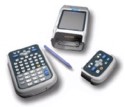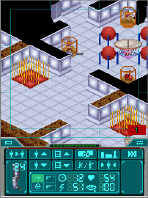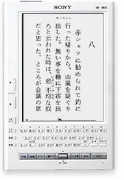Wed April 20 2005
 MS preparing new mobile IM client MS preparing new mobile IM client
|
|
11:33 AM by Colin Dunstan in Archive | Handhelds and Smartphones
Microsoft's Windows Mobile client will offer secure instant messaging and presence sharing across all types of wireless networks, real-time access to business contacts, and a familiar Windows interface. The first beta release of the client is expected to be released in the second half of 2005. |
|
[ 0 replies ] |
 The perfect mobile display The perfect mobile display
|
|
10:25 AM by Colin Dunstan in E-Book General | News The Feature is examining various display technologies that are currently on the market. Here is a summary: LCD type I: a transmissive display, works by shining a fluorescent backlight through a sandwich of glass and liquid crystal material. Fine for use indoors, but when you step outside in the daytime, you have to take your sunglasses off to use them. LCD type II: a reflective display, uses a frontlight. When the frontlight happens to be the sun, the resulting image is good. But in a low light condition, a reflective display has to use its built-in frontlight, and the quality is worse than a transmissive display. LCD type III: a transflective display, uses a backlight -- just like a transmissive display -- but can also use bright outdoor light to improve readability. An increasing number of mobile phones are using transflective displays (TFT LCDs) because it offers a compromise between transmissive and reflective displays. Bistable (aka e-paper): very low power-consumption and excellent legibility in both very bright and medium-light condition; alas very slow refresh rates. Examples: Boston's E-Ink, SiPix in Fremont, California, Dublin's Ntera, Nemoptic in France, ZBD in Worcester, and Kent Displays from Ohio OLED: organic light-emitting diode, generates light when a current is applied. Better than LCDs on some counts -- such as lower power consumption and a faster refresh rate -- but they do an even worse job than LCDs in bright sunlight, because they don't crank out enough nits to do the job. OLED pigments tend to fade over time, giving them a shorter life than LCDs. Others: iModD developed by Qualcomm uses iridescence to produce colors - in the the same way a butterfly's wings give off metallic looking hues. Uses reflected light, so it will work well in sunlight, and reduces power consumption. |
|
[ 0 replies ] |
 Database troubles Database troubles
|
|
09:13 AM by Alexander Turcic in Miscellaneous | Announcements Sorry for the recent downtime (from 04:47:15 to 08:44:51 -0400) today. We had issues with our database server and are still investigating. The MobileRead Team. |
|
[ 2 replies ] |
Tue April 19 2005
 Modular Windows Mobile Handheld Announced Modular Windows Mobile Handheld Announced
|
|
06:24 PM by Bob Russell in Archive | Handhelds and Smartphones
It's the CN30 from Intermec, and you can expect it on the market third quarter of this year. No price announced, but it has a VGA screen, speaker, mic, wifi, bluetooth, and is targeted to be a revolution in enterprise handhelds, so I wouldn't expect it to be in the typical consumer's budget. Nonetheless, it's good to see some creative design, and the modular concept may still have a place in consumer designs for the future. Read more at Windows For Devices. |
|
[ 1 reply ] |
 AP News Begins Charging Web News Providers AP News Begins Charging Web News Providers
|
|
03:41 PM by Bob Russell in Miscellaneous | Lounge
Note that AP is still providing news, and you seem to still be able to get the RSS feeds free at http://hosted.ap.org/dynamic/fronts/...B&SECTION=HOME. Plus, the sites that do pay the licensing costs (already about 300 customers) will continue to be providing the news. |
|
[ 1 reply ] |
 Pocket UFO 1.15 released Pocket UFO 1.15 released
|
|
12:58 PM by Colin Dunstan in Archive | Handhelds and Smartphones
Click here for the download. |
|
[ 0 replies ] |
 Orb Streaming - a positive account Orb Streaming - a positive account
|
|
12:41 PM by Colin Dunstan in Archive | Handhelds and Smartphones
Cool stuff. Seeing this work in person definitely makes you think that IDC's numbers might be a bit off. I think at least half of the mobile users in the U.S. will be using this stuff for real in just a few years, 30m is too low. Click here to read his full account. |
|
[ 0 replies ] |
 [Librie] Sony LIBRIe LE for Window 1.2 released [Librie] Sony LIBRIe LE for Window 1.2 released
|
|
11:54 AM by Colin Dunstan in More E-Book Readers | Legacy E-Book Devices
[via eBookSpot] |
|
[ 0 replies ] |


 Imagine that! A Windows Mobile PDA with a variety of "snap on" keyboards. A small one for minimal size, or a full querty keyboard, or even a pistol grip for scanning.
Imagine that! A Windows Mobile PDA with a variety of "snap on" keyboards. A small one for minimal size, or a full querty keyboard, or even a pistol grip for scanning.
 PocketGamer
PocketGamer  Russ has tested
Russ has tested  Sony has silently released an upgrade of
Sony has silently released an upgrade of  Latest E-Books
Latest E-Books

